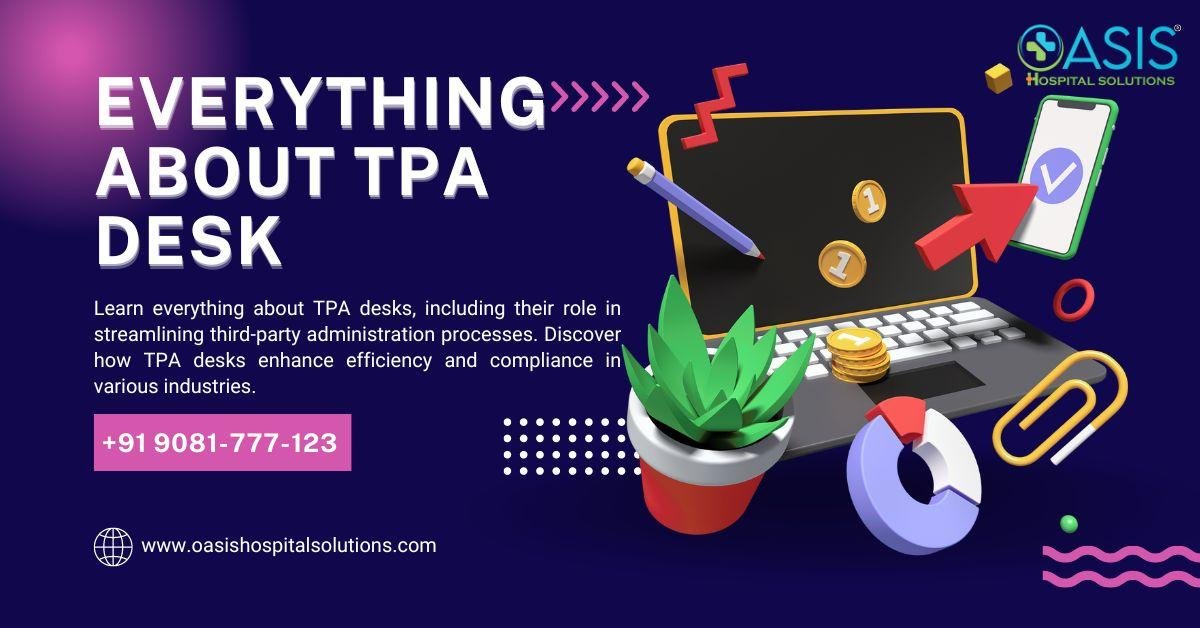Introduction TPA Desk
In today’s complex business landscape, efficient management of third-party administration (TPA) processes is crucial for ensuring organizational success. A key component in this endeavor is the TPA desk in Gujarat, a centralized platform designed to streamline and optimize TPA activities. In this comprehensive guide, we delve into everything you need to know about TPA desks, from their fundamental functions to their impact on organizational efficiency and compliance.
Understanding TPA Desk
In this section, we’ll explore the core concept of TPA desks and their significance in modern business operations.
What is a TPA Desk?
A TPA desk in Gujarat serves as a centralized hub for managing various aspects of third-party administration, including vendor relationships, contract management, and compliance monitoring. It acts as a bridge between organizations and their third-party service providers, facilitating seamless communication and collaboration.
Streamlining Vendor Management
TPA desks play a vital role in streamlining vendor management processes, allowing organizations to efficiently onboard, track, and evaluate third-party vendors.
Enhancing Contract Management
By centralizing contract management activities, TPA desks enable organizations to maintain oversight of contractual agreements, monitor key milestones, and ensure compliance with regulatory requirements.
The Role of TPA Desks in Compliance
Compliance is a top priority for organizations across industries, and TPA desks play a crucial role in ensuring adherence to regulatory standards and industry best practices.
Monitoring Regulatory Changes
TPA desks provide organizations with tools to monitor regulatory changes and updates, allowing them to adapt their processes and procedures accordingly to maintain compliance.
Facilitating Audits and Reporting
With robust reporting capabilities, TPA desks simplify the audit process by providing comprehensive documentation of TPA activities, ensuring transparency and accountability.
Benefits of Implementing a TPA Desk
In this section, we’ll explore the numerous benefits that organizations can derive from implementing a TPA desk solution.
Improved Efficiency and Productivity
By centralizing TPA activities and automating routine tasks, TPA desks significantly enhance operational efficiency, allowing organizations to allocate resources more effectively and focus on strategic initiatives.
Enhanced Risk Management
TPA desks provide organizations with greater visibility into their third-party relationships, enabling proactive identification and mitigation of potential risks, such as compliance violations and operational disruptions.
Cost Savings
Through process optimization and resource consolidation, TPA desks help organizations reduce operational costs associated with third-party administration, resulting in significant long-term savings.
Key Considerations When Choosing a TPA Desk
In this section, we’ll outline some key factors to consider when selecting a TPA desk solution for your organization.
Scalability and Flexibility
Choose a TPA desk solution that can scale with your organization’s evolving needs and offers flexibility to accommodate changes in your third-party ecosystem.
Integration Capabilities
Look for a TPA desk solution that seamlessly integrates with your existing systems and technologies, minimizing disruption and maximizing efficiency.
Security and Compliance Features
Prioritize TPA desk solutions that prioritize robust security measures and compliance features to safeguard sensitive data and ensure regulatory compliance.
Common Challenges and Best Practices
In this section, we’ll explore some common challenges associated with TPA desks and highlight best practices for overcoming them.
Data Quality and Integrity
Maintaining data quality and integrity is crucial for the effective operation of TPA desks. Implement robust data validation processes and regular audits to ensure data accuracy and consistency.
Change Management
Successfully implementing a TPA desk requires effective change management strategies to overcome resistance and foster adoption among stakeholders. Communicate the benefits of the TPA desk clearly and provide comprehensive training and support to users.
FAQs
What industries benefit most from TPA Desk?
- TPA Desks are valuable across various industries, including healthcare, finance, manufacturing, and retail. Any organization that relies on third-party vendors for critical services can benefit from implementing a TPA desk.
How does a TPA Desk improve vendor management?
- A TPA Desk centralizes vendor management activities, providing organizations with a single platform to onboard vendors, track performance, and manage contracts. This streamlines communication and enhances transparency in vendor relationships.
Is compliance monitoring automated with a TPA desk?
- While compliance monitoring can be automated to a certain extent with TPA desks, ongoing oversight and review are still necessary to ensure adherence to regulatory requirements. TPA desks provide tools and reporting capabilities to facilitate compliance monitoring and reporting.
Can TPA desks be customized to suit specific organizational needs?
- Yes, many TPA desk solutions offer customization options to tailor the platform to the unique needs and requirements of each organization. This ensures that the TPA desk aligns with existing processes and workflows, maximizing its effectiveness.
How can organizations measure the ROI of implementing a TPA Desk?
- Organizations can measure the ROI of a TPA Desk by evaluating improvements in efficiency, cost savings, and risk mitigation over time. By tracking key performance indicators and comparing them to pre-implementation benchmarks, organizations can quantify the value of their investment.
What role does automation play in TPA desk?
- Automation is a central feature of TPA Desks, enabling organizations to streamline repetitive tasks, such as data entry, document processing, and reporting. By automating routine processes, TPA desks free up valuable time and resources, allowing staff to focus on more strategic activities.
Conclusion
In conclusion, TPA Desks play a pivotal role in streamlining third-party administration processes, enhancing efficiency, and ensuring compliance across industries. By centralizing vendor management, facilitating compliance monitoring, and automating routine tasks, TPA desks empower organizations to optimize their third-party relationships and achieve their strategic objectives.




